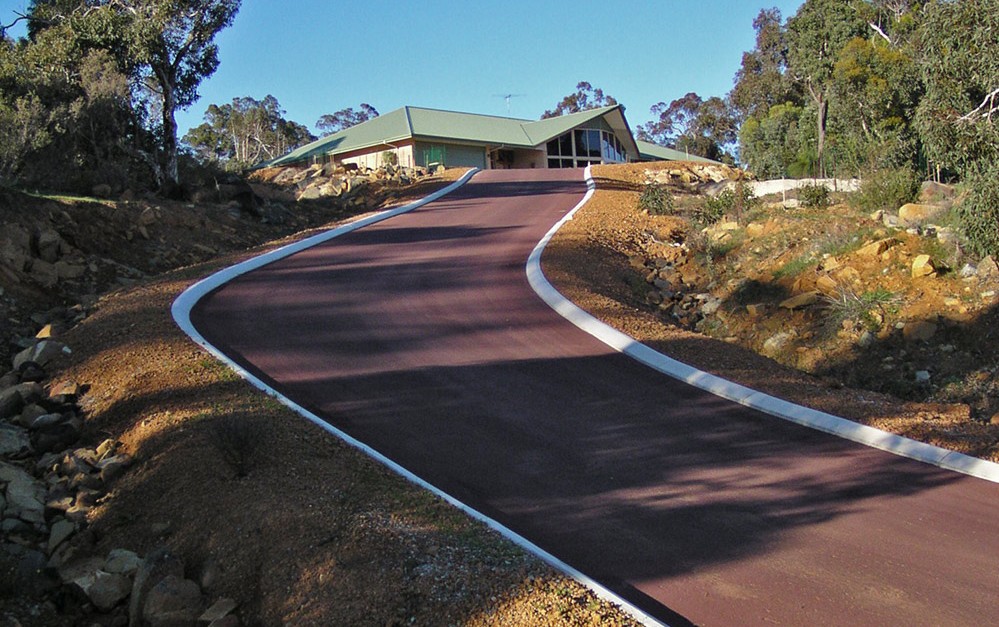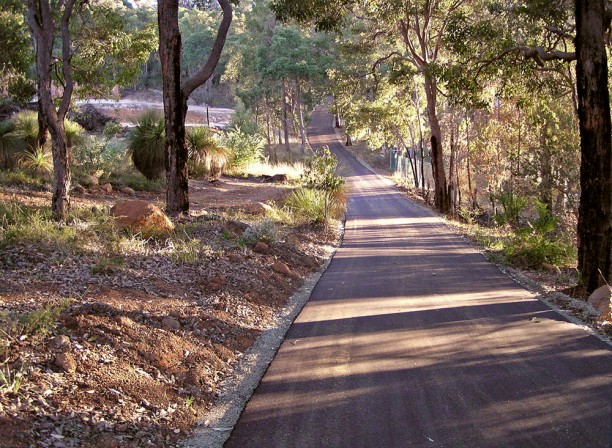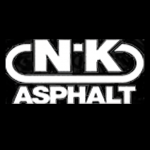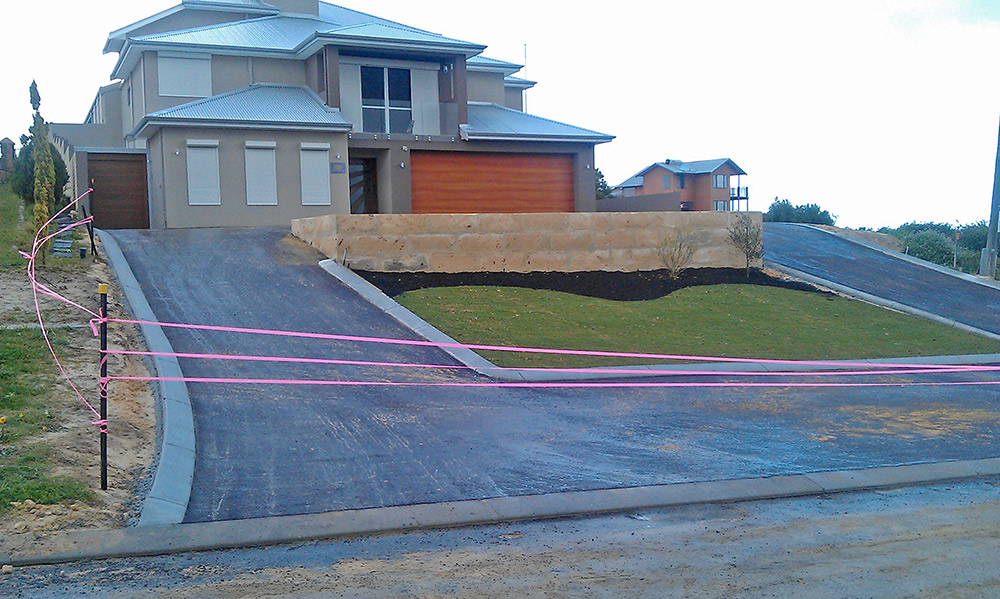You may love your house and it’s location on a hill, but steep driveways can have a range of problems, including losing grip in wet weather, water damage and vehicles scraping. Many owners have difficulties using their driveways due to bottoming out their cars on a steep driveway, which asks the question – what is the steep driveway solution?
In many cases, steep driveway design problems can be fixed by resurfacing the driveway and correcting the gradient to increase ground clearance and allow for water runoff. After fixing your steep driveway you’ll wonder why you hadn’t done it sooner and finally be able to easily pull up to your front door without risking car damage.
We’ve summarised the main problems people face with steep driveways in Perth and a choice of solutions for each.
Driveway Gradient
Having a too steep driveway gradient is the main cause of headaches for homeowners with sloping driveways. Driveways that are too steep can lead to cars bottoming out or scrapping, water pooling or lack of grip for vehicles.
For vehicles to easily traverse a driveway, Main Roads WA recommends a maximum grade range of 5-8% for commercial vehicles and 10-15% (approx. 1 in 10 to 1 in 7 gradients) for other vehicles. This is fine when cars are on the gradient, but often the vehicle damage is caused at either the top or bottom of the driveway when cars are entering or exiting the gradient.
WALGA recommends the maximum change of grade along a driveway shall not be more than 12% (approx. 1 in 8 gradient). This is to ensure vehicle undersides have clearance over sharp changes of grade and do not “bottom out” on the driveway.
What’s the steep driveway solution?
If your vehicles are bottoming out from a steep driveway, here are a few solutions:
- Add in transition gradients at the top and bottom of your driveway to increase the ground clearance for vehicles. Reducing the change of gradient to less than 12% by transitioning in two stages or more, should allow vehicles to use the driveway without scraping the front, middle or back.

Graphic indicating how to safely surface a steep driveway.
- To reduce the gradient of the vehicle at the top or bottom of a steep driveway, curve the driveway to allow vehicles to enter and exit at an angle. This will reduce the gradient compared to driving straight up or down.

Asphalt driveway with dual paths and a custom garden in the centre.
- By zig-zagging a steep driveway, instead of going directly up or down the hill, you will reduce the gradient of the entire driveway by adding length to it. You’ll have a longer driveway, but you’ll avoid damage to your vehicles. This also helps with water dispersal.

A steep driveway created with red asphalt and white kerbing by NK Asphalt.
Steep Driveway Solutions
Steep driveways can be challenging, but with the right approach, they can be effectively managed. NK Asphalt offers a range of solutions for steep driveways, including the use of high-quality asphalt with a rough texture to increase traction, and the implementation of drainage systems to prevent water accumulation. Our team of experienced professionals can assess your driveway and recommend the best solution for your specific needs.
Driveway Grip
Having a driveway with decent traction and grip is essential for steep driveways, especially for heavy vehicles. Due to the slope of driveways in hilly areas, vehicles need more speed and control to navigate their way.
If traction is lost between the tyres and the driveway it could result in vehicle, property or personal damage.
What’s the solution?
When surfacing your driveway, choose a material that will grip even in wet weather. Here’s a comparison of steep driveway surfacing materials:
Concrete
A popular choice for long driveways but because of its sometimes smooth surface, can offer reduced grip for vehicles on a steep driveway, especially in wet weather.
Paving or Bricks
A more expensive choice for long driveways, bricks and paving can offer more grip compared to concrete but can be more prone to movement and spreading of the paving bricks over time.
Gravel, limestone or roadbase
An initially cost-effective and versatile choice for large driveways. Gravel, limestone and roadbase offer grip for vehicles but will become loose under traffic, especially on steep driveways and once that happens, vehicles can lose traction and an uneven, possibly rutted surface results, with ongoing maintenance grading/repairs being required.
Asphalt
Asphalt has far better grip than gravel and is a good alternative to concrete. Asphalt is a mixture of aggregate and bitumen that creates a durable and weather-resistant surface material that is ideal for steep driveways of up to around a 1 in 6 or a 10-degree gradient. Best of all, for long driveways, it’s extremely cost-effective. The majority of roads around Perth are asphalt.
For driveways over 10 degrees, concrete is often the only viable solution, as asphalt can be difficult to lay and compact as well as a safety concern for machine operators and the crew. Brick paving, recycled asphalt and unsealed materials also don’t give a good long term solution.

A long residential asphalt driveway in Darlington, WA.
Driveway Drainage
Driveways need drainage to avoid water erosion, pooling and causing run-off damage, but for long steep driveways, it is even more essential, as water from the entire driveway will head in one direction. In wet weather, the water landing on a steep driveway will mostly be heading downhill to the lowest point, unlike on flat driveways where the water is spread more evenly.
If you have a steep driveway, you’ve probably seen the puddles or washouts from water running down the hill. Whilst it might not be too much of an inconvenience if the puddles dry quickly, any water that sits for too long can be causing damage to the driveway, as the underlying subgrade and base material become waterlogged.
You also have a legal obligation in WA to confine stormwater runoff to your property when possible, this includes rain runoff from steep driveways.
What’s the solution?
Water is the enemy of driveways for many reasons including mould, surface cracks, potholes, washout damage and potential property damage. The design of the driveway is important to remove water from your driveway and disperse it in the surrounding soil through dispersion along the drive, soakwells or other drainage methods.
Driveway drainage will not only protect your driveway and house from water damage, but you’ll be meeting Perth and WA regulations and most importantly have peace of mind when it rains.
For the Long and Steep Driveway Solution in Perth…
If you’ve got a steep driveway that is causing you headaches, speak to the team at NK Asphalt. We have been helping Perth homeowners and businesses create vehicle-friendly steep driveways for over 30 years and especially in the Perth hills surfacing and resurfacing steep driveways with new asphalt.
We can help by changing driveway gradients, installing drainage and kerbing, and surfacing your driveway with durable asphalt in a colour of your choice.
We’re a highly experienced, family-owned business and we pride in delivering quality asphalt driveways with friendly customer service.
We’ll even advise you that if in our opinion your drive isn’t suited to using asphalt, we’ll offer advice on an alternative.
If you have any questions about asphalt driveways, contact our team today or request a free on-site quote or advice over the phone.
Driveway Gradient Calculator
| Slope | |||
| Angle | Gradient | Grade | |
| (degrees) | Y | X | (%) |
| 0.1 | 1 | 573 | 0.17 |
| 0.2 | 1 | 286.5 | 0.35 |
| 0.3 | 1 | 191 | 0.52 |
| 0.4 | 1 | 143.2 | 0.7 |
| 0.5 | 1 | 114.6 | 0.87 |
| 0.57 | 1 | 100 | 1 |
| 0.6 | 1 | 95.49 | 1.05 |
| 0.7 | 1 | 81.85 | 1.22 |
| 0.8 | 1 | 71.62 | 1.4 |
| 0.9 | 1 | 63.66 | 1.57 |
| 1 | 1 | 57.29 | 1.75 |
| 2 | 1 | 28.64 | 3.49 |
| 3 | 1 | 19.08 | 5.24 |
| 4 | 1 | 14.3 | 6.99 |
| 5 | 1 | 11.43 | 8.75 |
| 5.74 | 1 | 10 | 10 |
| 6 | 1 | 9.514 | 10.5 |
| 7 | 1 | 8.144 | 12.3 |
| 8 | 1 | 7.115 | 14.1 |
| 9 | 1 | 6.314 | 15.8 |
| 10 | 1 | 5.671 | 17.6 |
| 11 | 1 | 5.145 | 19.4 |
| 12 | 1 | 4.705 | 21.3 |
| 13 | 1 | 4.331 | 23.1 |
| 14 | 1 | 4.011 | 24.9 |
| 15 | 1 | 3.732 | 26.8 |
| 16 | 1 | 3.487 | 28.7 |
| 17 | 1 | 3.271 | 30.6 |
| 18 | 1 | 3.078 | 32.5 |
| 19 | 1 | 2.904 | 34.4 |
| 20 | 1 | 2.747 | 36.4 |
| 21 | 1 | 2.605 | 38.4 |
| 22 | 1 | 2.475 | 40.4 |
| 23 | 1 | 2.356 | 42.4 |
| 24 | 1 | 2.246 | 44.5 |
| 25 | 1 | 2.145 | 46.6 |
| 26 | 1 | 2.05 | 48.8 |
| 27 | 1 | 1.963 | 51 |
| 28 | 1 | 1.881 | 53.2 |
| 29 | 1 | 1.804 | 55.4 |
| 30 | 1 | 1.732 | 57.7 |
| 31 | 1 | 1.664 | 60.1 |
| 32 | 1 | 1.6 | 62.5 |
| 33 | 1 | 1.54 | 64.9 |
| 34 | 1 | 1.483 | 67.5 |
| 35 | 1 | 1.428 | 70 |
| 36 | 1 | 1.376 | 72.7 |
| 37 | 1 | 1.327 | 75.4 |
| 38 | 1 | 1.28 | 78.1 |
| 39 | 1 | 1.235 | 81 |
| 40 | 1 | 1.192 | 83.9 |
| 41 | 1 | 1.15 | 86.9 |
| 42 | 1 | 1.111 | 90 |
| 43 | 1 | 1.072 | 93.3 |
| 44 | 1 | 1.036 | 96.6 |
| 45 | 1 | 1 | 100 |
| 46 | 1 | 0.9657 | 103.6 |
| 47 | 1 | 0.9325 | 107.2 |
| 48 | 1 | 0.9004 | 111.1 |
| 49 | 1 | 0.8693 | 115 |
| 50 | 1 | 0.8391 | 119.2 |
| 51 | 1 | 0.8098 | 123.5 |
| 52 | 1 | 0.7813 | 128 |
| 53 | 1 | 0.7536 | 132.7 |
| 54 | 1 | 0.7265 | 137.6 |
| 55 | 1 | 0.7002 | 142.8 |
| 56 | 1 | 0.6745 | 148.3 |
| 57 | 1 | 0.6494 | 154 |
| 58 | 1 | 0.6249 | 160 |
| 59 | 1 | 0.6009 | 166.4 |
| 60 | 1 | 0.5774 | 173.2 |
| 61 | 1 | 0.5543 | 180.4 |
| 62 | 1 | 0.5317 | 188.1 |
| 63 | 1 | 0.5095 | 196.3 |
| 64 | 1 | 0.4877 | 205 |
| 65 | 1 | 0.4663 | 214.5 |
| 66 | 1 | 0.4452 | 224.6 |
| 67 | 1 | 0.4245 | 235.6 |
| 68 | 1 | 0.404 | 247.5 |
| 69 | 1 | 0.3839 | 260.5 |
| 70 | 1 | 0.364 | 274.7 |
| 71 | 1 | 0.3443 | 290.4 |
| 72 | 1 | 0.3249 | 307.8 |
| 73 | 1 | 0.3057 | 327.1 |
| 74 | 1 | 0.2867 | 348.7 |
| 75 | 1 | 0.2679 | 373.2 |
| 76 | 1 | 0.2493 | 401.1 |
| 77 | 1 | 0.2309 | 433.1 |
| 78 | 1 | 0.2126 | 470.5 |
| 79 | 1 | 0.1944 | 514.5 |
| 80 | 1 | 0.1763 | 567.1 |
| 81 | 1 | 0.1584 | 631.4 |
| 82 | 1 | 0.1405 | 711.5 |
| 83 | 1 | 0.1228 | 814.4 |
| 84 | 1 | 0.1051 | 951.4 |
| 85 | 1 | 0.08749 | 1143 |
| 86 | 1 | 0.06993 | 1430 |
| 87 | 1 | 0.05241 | 1908 |
| 88 | 1 | 0.03492 | 2864 |
| 89 | 1 | 0.01746 | 5729 |
| 90 | 1 | 0 | ∞ |
| 1% grade = 0.57 degrees = 10mm per 1 metre | |||
Get a Perth asphalt quote for a steep driveway solution
If your driveway is 150m2 or more and in the Perth or surrounding areas.
share


